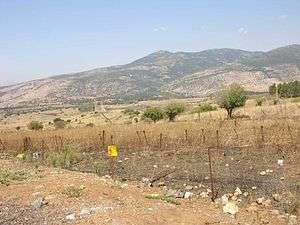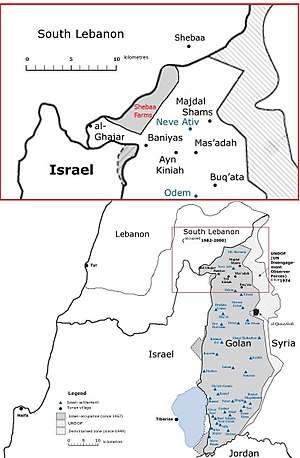2000–2006 Shebaa Farms conflict
The 2000–2006 Shebaa Farms conflict was a low level border conflict consisting of Hezbollah rocket and mortar attacks on the Israeli Defense Forces and IDF artillery barrages and air strikes in Southern Lebanon. Clashes followed the withdrawal of Israeli troops from South Lebanon in 2000, which Hezbollah viewed as incomplete due to the presence of Israeli troops in the disputed Shebaa farms. Fighting came to an end after the 2006 Lebanon War.
| Shebaa Farms conflict | |||||||
|---|---|---|---|---|---|---|---|
| Part of the Hezbollah–Israel conflict | |||||||
 Tel Faher mine fields, Golan Heights, with the Shebaa Farms in the background (2009) | |||||||
| |||||||
| Belligerents | |||||||
|
|
| ||||||
| Commanders and leaders | |||||||
|
|
| ||||||
| Casualties and losses | |||||||
|
16 killed 37 wounded 2 captured |
At the very least 13 militants killed 2 officials assassinated | ||||||
|
9 Israeli civilians killed and 8 wounded Unknown Lebanese civilian casualties 1 Syrian soldier killed and 7 wounded 1 Lebanese soldier wounded 1 French UNIFIL soldier killed | |||||||

Timeline of attacks
- 7 October 2000 - Hezbollah launched a cross-border raid. Three IDF soldiers were killed and their bodies were captured. Five people were subsequently injured by Israeli artillery fire.
- 26 November 2000 - An explosive charge was detonated while an IDF force was on a road opening mission. One soldier was killed and two wounded.
- 31 January 2001 - Six mortar bombs were fired at an Israeli outpost near the Lebanese border, causing no casualties.
- 16 February 2001 - Antitank fire hit an IDF convoy. One soldier was killed and three wounded. Israel responded with airstrikes on targets in South Lebanon.
- 14 April 2001 - An antitank missile was fired at an IDF tank, killing a soldier. In response, Israeli aircraft bombed a Syrian radar station in Lebanon, killing a Syrian soldier and injuring four others.[2]
- 29 June 2001 - Hezbollah fighters fired antitank missiles and mortar shells at IDF positions, injuring two soldiers.
- 1 July, IAF warplanes bombed a Syrian radar station in Lebanon, wounding three Syrian soldiers and a Lebanese soldier. Hezbollah responded by shelling positions in northern Israel. IAF helicopter gunships then attacked Hezbollah positions.[3]
- 12 March 2002 - Hezbollah fire killed six Israeli civilians, including an off-duty IDF officer.[4]
- 29 August 2002 - One IDF soldier was killed and two soldiers were injured in rocket fire.
- December 2002 - Israeli aircraft carried out numerous airstrikes throughout Lebanon. As well as targeting roads, bridges, and ammunition depots, they also bombed several power and electrical transformer stations throughout Lebanon, leaving large parts of Beirut and its suburbs, communities in the Chouf District, Baalbek, and Bint Jbeil without electricity. Meanwhile, Hezbollah rocket fire hit Kiryat Shmona, killing two Israeli civilians.[5]
- 7 May 2003 - Hezbollah attacked IDF positions in Shebaa farms with rockets, mortars, and small arms, killing a soldier and wounding five.
- 20 July 2003 - Hezbollah snipers killed two IDF soldiers at a border post. The IDF retaliated with tank fire at a Hezbollah position, killing a Hezbollah fighter. The IAF launched multiple flights over Lebanon, two of which generated powerful sonic booms over Beirut.
- 22 July 2003 - Two Israeli civilians in Shlomi were wounded by Hezbollah anti-aircraft shells fired at IAF warplanes over South Lebanon.
- 2 August 2003 - Hezbollah member Ali Hussein Saleh was assassinated by a car bomb in Beirut, allegedly by Israeli intelligence.[6]
- 3 August 2003 - Hezbollah militants fired rockets and mortars at three Israeli military positions in Shebaa farms. Israel retaliated with airstrikes.
- 10 August 2003 - An Israeli teenager was killed and four civilians wounded by shrapnel from a Hezbollah anti-aircraft shell fired into northern Israel.
- 6 October 2003 - One IDF soldier was killed by Hezbollah gunfire. Hezbollah anti-tank missiles and rockets were also fired at an IDF post in the Reaches Ramim area.
- 19 January 2004 - An Israeli soldier was killed and another severely wounded after a Hezbollah anti-tank missile struck an IDF armored bulldozer that crossed into Lebanon to clear explosives.
- 20 January 2004 - Israel bombed two Hezbollah bases in the Bekaa Valley, causing an unknown number of casualties.[7]
- 7 May 2004 - Hezbollah fire killed one Israeli soldier and severely wounded two others. Afterwards, both Israel and Hezbollah shelled each other across the border.[8]
- 19 July 2004 - Hezbollah official Ghaleb Awwali was assassinated by a car bomb, allegedly by Israeli agents.
- 20 July 2004 - Hezbollah sniper fire killed two IDF soldiers at a border post. In retaliation, Israeli helicopter gunships fired missiles at Hezbollah positions, and an Israeli tank fired at a Hezbollah post near Ayta ash Shab, killing a Hezbollah fighter. Hezbollah fighters on the border returned fire, and subsequently came under attack from Israeli helicopters.[9]
- 9 January 2005 - A roadside bomb attack in northern Israel killed one soldier. Israel responded with shelling, during which a French officer serving with UNIFIL was killed and a Swedish officer and Lebanese civilian were wounded.[10][11]
- 7 April 2005 - Two Israeli Arabs from Ghajar were kidnapped by Hezbollah and held for four days, interrogated, and released.
- June 2005 - An Israeli Paratrooper unit discovered three Hezbollah fighters attempting to infiltrate and opened fire, killing one.
- 29 June 2005 - After an Israeli soldier was killed and four wounded by Hezbollah mortar fire, Israeli warplanes and artillery launched attacks against Hezbollah in southern Lebanon.[12]
- 30 June 2005 - Hezbollah guerrillas launched an attack on Israeli forces in Shebaa farms, wounding six soldiers. Israel responded with an airstrike that killed a Hezbollah fighter.[13]
- 21 November 2005 - Five Hezbollah guerrillas crossed into the Israel-occupied Golan Heights using motorcycles and ATVs, and attacked an outpost in Ghajar manned by an IDF paratrooper unit. All five attackers were killed by a sniper from the paratrooper unit. In response, Israeli warplanes struck Hezbollah targets in southern Lebanon; Hezbollah responded by firing mortars and rockets at Israeli outposts and villages, wounding nine soldiers and two civilians.[14][15]
- 28 December 2005 - After rocket fire from Lebanon hits Northern Israel, Israeli warplanes bombed a guerrilla base south of Beirut.
- 27 May 2006 - In what was described as the most intense clash since the withdraw of Israeli troops in 2000, Hezbollah fired rockets into northern Israel, wounding a soldier. Israel responded with airstrikes, killing two Hezbollah fighters. The Hezbollah attack may have been retaliation for the killing of Mahmoud al-Majzoub.[16]
Aftermath
Walid Jumblatt, a Lebanese Druze politician and leader of the Progressive Socialist Party, stated that Lebanon has no claims to the Shebaa Farms.[17] The prime minister and president stated that Lebanon has a claim to the area.[18]
Following the Israeli war against Hezbollah in 2006, U.N. Security Council Resolution 1701 called for the "Delineation of the international borders of Lebanon, especially in those areas where the border is disputed or uncertain, including in the Shebaa farms area."[19]
On 28 August 2006, Hezbollah fighters withdrew from positions near the Shebaa Farms area.[20]
See also
References
- A. Kaufman. The Israel-Hezbollah Conflict and the Shebaa Farms. The Joan B. Croc Institute. 2006.
- "Israelis Attack Syrian Radar in Lebanon". 16 April 2001. Retrieved 6 February 2015.
- "BBC News - MIDDLE EAST - Israel attacks Syrian radar station". Retrieved 6 February 2015.
- "Israel Ministry of Foreign Affairs". GxMSDev. Retrieved 6 February 2015.
- "Human Rights Watch - Defending Human Rights Worldwide". Archived from the original on 6 February 2015. Retrieved 6 February 2015.
- "BBC NEWS - Middle East - Beirut blast kills Hezbollah fighter". Retrieved 6 February 2015.
- "BBC NEWS - Middle East - Israeli jets hit Lebanon targets". Retrieved 6 February 2015.
- "CNN.com - Israel, Hezbollah battle across Lebanese border - May 7, 2004". Retrieved 6 February 2015.
- "Moscow-Pullman Daily News - Google News Archive Search". Retrieved 6 February 2015.
- S/2005/36 of 20 January 2005
- "Archived copy". Archived from the original on 14 September 2016. Retrieved 17 January 2016.CS1 maint: archived copy as title (link)
- "BBC NEWS - Middle East - Israeli killed in Hezbollah clash". Retrieved 6 February 2015.
- http://articles.boston.com/2005-06-30/news/29218354_1_hezbollah-attacks-hezbollah-positions-hezbollah-guerillas%5B%5D
- "Israel, Hezbollah blame each other for clash". Retrieved 6 February 2015.
- "National & World News on Newsday.com - Newsday". Newsday. Retrieved 6 February 2015.
- Israel and Militants Trade Fire Across Lebanese Border - New York Times
- Waked, All (15 March 2005). "Lebanese leader: Mount Dov not ours". Ynetnews. Retrieved 29 September 2006.
- Wright, Jonathan (29 August 2006). "News analysis: Hezbollah seen surviving UN troop expansion". The Gazette. Archived from the original on 18 February 2008. Retrieved 29 September 2006.
- http://www.jewishpolicycenter.org/831/syria-and-the-shebaa-farms-dispute
- Wright, Jonathan (29 August 2006). "News analysis: Hezbollah seen surviving UN troop expansion". The Gazette. Archived from the original on 18 February 2008. Retrieved 29 September 2006.